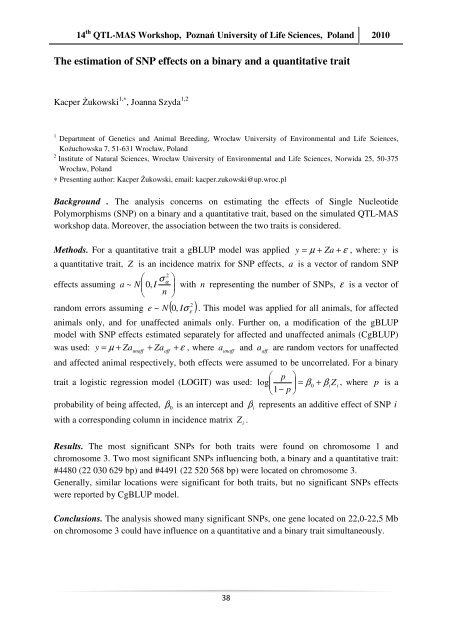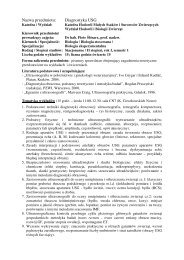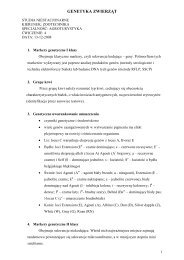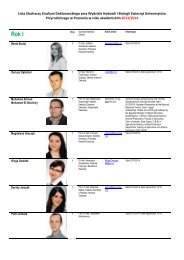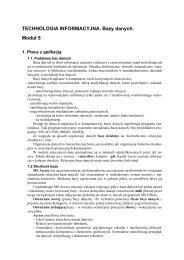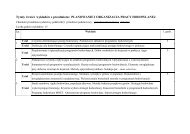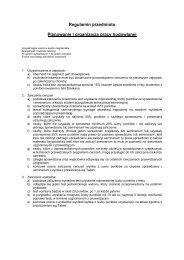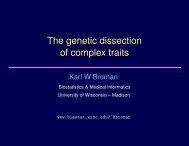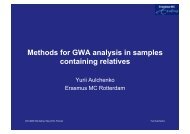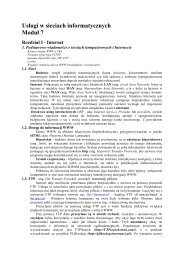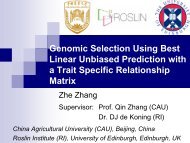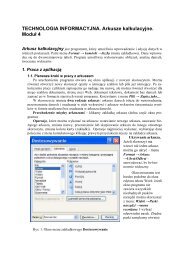14 th QTL-MAS Workshop, Poznań University <strong>of</strong> Life Sciences, Poland 2010<strong>The</strong> estimation <strong>of</strong> SNP effects on a binary and a quantitative traitKacper Żukowski 1,∗ , Joanna Szyda 1,21Department <strong>of</strong> Genetics and Animal Breeding, Wrocław University <strong>of</strong> Environmental and Life Sciences,Kożuchowska 7, 51-631 Wrocław, Poland2Institute <strong>of</strong> Natural Sciences, Wrocław University <strong>of</strong> Environmental and Life Sciences, Norwida 25, 50-375Wrocław, Poland∗ Presenting author: Kacper Żukowski, email: kacper.zukowski@up.wroc.plBackground . <strong>The</strong> analys<strong>is</strong> concerns on estimating the effects <strong>of</strong> Single NucleotidePolymorph<strong>is</strong>ms (SNP) on a binary and a quantitative trait, based on the simulated QTL-MASworkshop data. Moreover, the association between the two traits <strong>is</strong> considered.Methods. For a quantitative trait a gBLUP model was appliedy = µ + Za + ε , where: y <strong>is</strong>a quantitative trait, Z <strong>is</strong> an incidence matrix for SNP effects, a <strong>is</strong> a vector <strong>of</strong> random SNPeffects assuminga2⎛ σ⎟ ⎞N⎜0,I with n representing the number <strong>of</strong> SNPs, ε <strong>is</strong> a vector <strong>of</strong>⎝ n ⎠~α2random errors assuming e N( 0, Iσ )~ε. Th<strong>is</strong> model was applied for all animals, for affectedanimals only, and for unaffected animals only. Further on, a modification <strong>of</strong> the gBLUPmodel with SNP effects estimated separately for affected and unaffected animals (CgBLUP)was used: y = µ + Za unaff+ Zaaff+ ε , where aunaffand aaffare random vectors for unaffectedand affected animal respectively, both effects were assumed to be uncorrelated. For a binarytrait a log<strong>is</strong>tic regression model (LOGIT) was used:probability <strong>of</strong> being affected, β0<strong>is</strong> an intercept andwith a corresponding column in incidence matrix⎛ p ⎞log ⎜ ⎟ = β0+ β⎝1−p ⎠Z i i, where p <strong>is</strong> aβirepresents an additive effect <strong>of</strong> SNP iResults. <strong>The</strong> most significant SNPs for both traits were found on chromosome 1 andchromosome 3. Two most significant SNPs influencing both, a binary and a quantitative trait:#4480 (22 030 629 bp) and #4491 (22 520 568 bp) were located on chromosome 3.Generally, similar locations were significant for both traits, but no significant SNPs effectswere reported by CgBLUP model.Conclusions. <strong>The</strong> analys<strong>is</strong> showed many significant SNPs, one gene located on 22,0-22,5 Mbon chromosome 3 could have influence on a quantitative and a binary trait simultaneously.Zi.38
14 th QTL-MAS Workshop, Poznań University <strong>of</strong> Life Sciences, Poland 2010Logic regression based methods in application to detection <strong>of</strong> gene-geneinteractionsMagdalena Malina 1* , Małgorzata Bogdan 21 Mathematical Institute, University <strong>of</strong> Wrocław2 Institute <strong>of</strong> Mathematics and Computer Science, Wrocław University <strong>of</strong> Technology,∗ Presenting author: Magdalena Malina, email: malina@math.uni.wroc.plBackground. We consider a biological problem <strong>of</strong> locating multiple interacting QTLs. Logicregression introduced in [2] by Ruczinski, Kooperberg, LeBlanc <strong>is</strong> a regression method,specifically aimed at detecting high order interactions in SNP data. <strong>The</strong> method attempts toconstruct predictors as Boolean combinations <strong>of</strong> dummy variables coding marker genotypes.<strong>The</strong> method searches for these combinations <strong>of</strong> predictors in the entire space <strong>of</strong> suchcombinations, which are represented by logic binary trees. In [1] Schwender and Ickstadtpropose a procedure called logicFS (logic feature selection) in which the “best” model <strong>of</strong> afixed dimension <strong>is</strong> estimated with simulated annealing, aimed at maximizing the likelihood.<strong>The</strong> instability <strong>of</strong> binary trees <strong>is</strong> overcome by using bootstrap aggregation. Based on bootstrapreplications, for each interaction an importance measure <strong>is</strong> calculated. <strong>The</strong> method can beapplied for both binary and quantitative responses.Results. We applied LogicFS for QTL mapping. We analyzed two real QTL data sets (see[3], [4]). <strong>The</strong> data by Lyons et.al ([3]) contains different phenotypes related to cholesterolgallstone formation detected in an intercross <strong>of</strong> CAST/Ei and 129S1/SvImJ inbred mice. Wesearched for interactions that influence gallbladder bile character<strong>is</strong>tics (binary variable). <strong>The</strong>second data set ([4]) considers different phenotypes related to obesity detected in an intercross<strong>of</strong> SM/J and NZB/BINJ inbred mice. Here we searched for interactions that influence gonadalfat pads weight. For both data sets logicFS was able to detect several interactions which werenot reported in original papers.Conclusions. Logic regression models allow to present very complex linear models withmany parameters in a much simpler form. Increasing number <strong>of</strong> components that may beincluded to models <strong>of</strong> th<strong>is</strong> form causes also that the problem <strong>of</strong> multiple testing become morecomplex. In such models however it <strong>is</strong> easier to get to the higher order interactions withoutaddition <strong>of</strong> new parameters. Interactions included in such model are also much easier tointerpret. According to our results, logicFS can be successfully applied to identification <strong>of</strong>interacting QTLs.[1]Schwender, H. and Ickstadt, K. (2008). Biostat<strong>is</strong>tics, 9. 187-198[2] Ruczinski I., Kooperberg C., LeBlanc M. (2003). J. Comput. Graphical Stat<strong>is</strong>t. 12 (3) 474-511[3] Lyons MA, Wittenburg H, Li R, Walsh KA, Leonard MR, Churchill GA, Carey MC, Paigen B. Physiol Genomics. 2003Aug 15;14(3):225-39. PMID 12837957[4] Stylianou IM, Korstanje R, Li R, Sheehan S, Paigen B, Churchill GA. Mamm Genome. 2006 Jan;17(1):22-36. PMID1641608839
- Page 2 and 3: The book of abstracts14 th QTL - MA
- Page 4 and 5: HONORARY PATRONAGE14 th QTL-MAS 201
- Page 6 and 7: CONTENTSPROGRAM………………
- Page 8 and 9: 14 th QTL-MAS Workshop, Poznań Uni
- Page 10 and 11: 14 th QTL-MAS Workshop, Poznań Uni
- Page 12 and 13: 14 th QTL-MAS Workshop, Poznań Uni
- Page 14 and 15: 14 th QTL-MAS Workshop, Poznań Uni
- Page 16 and 17: 14 th QTL-MAS Workshop, Poznań Uni
- Page 18 and 19: 14 th QTL-MAS Workshop, Poznań Uni
- Page 20 and 21: 14 th QTL-MAS Workshop, Poznań Uni
- Page 22 and 23: 14 th QTL-MAS Workshop, Poznań Uni
- Page 24 and 25: 14 th QTL-MAS Workshop, Poznań Uni
- Page 26 and 27: 14 th QTL-MAS Workshop, Poznań Uni
- Page 28 and 29: 14 th QTL-MAS Workshop, Poznań Uni
- Page 30 and 31: 14 th QTL-MAS Workshop, Poznań Uni
- Page 32 and 33: 14 th QTL-MAS Workshop, Poznań Uni
- Page 34 and 35: 14 th QTL-MAS Workshop, Poznań Uni
- Page 36 and 37: 14 th QTL-MAS Workshop, Poznań Uni
- Page 40 and 41: 14 th QTL-MAS Workshop, Poznań Uni
- Page 42 and 43: 14 th QTL-MAS Workshop, Poznań Uni
- Page 44 and 45: 14 th QTL-MAS Workshop, Poznań Uni
- Page 46 and 47: 14 th QTL-MAS Workshop, Poznań Uni


